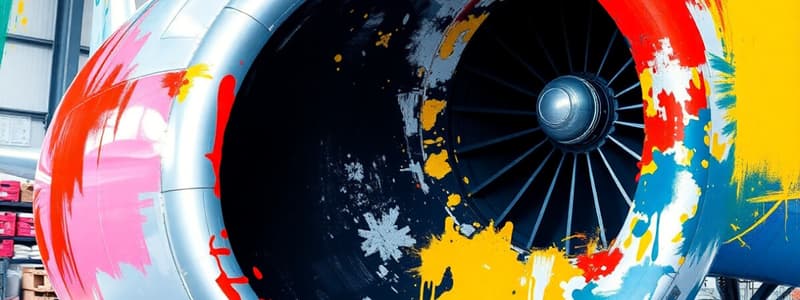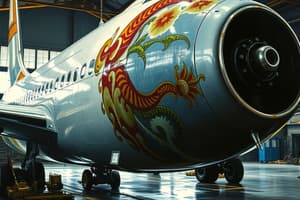Podcast
Questions and Answers
Why are nicks on propeller blades important to inspect?
Why are nicks on propeller blades important to inspect?
- They enhance blade lubrication.
- They reduce drag.
- They improve fuel efficiency.
- They produce stress concentrations. (correct)
What is a 'lifed item' on an aircraft?
What is a 'lifed item' on an aircraft?
- An item with unlimited fatigue life.
- An item that improves with age.
- An item that never needs replacement.
- An item with a specific time in service. (correct)
Who typically monitors 'lifed items'?
Who typically monitors 'lifed items'?
- The company technical department. (correct)
- The passengers.
- The pilot.
- The air traffic controller.
Why are light bulbs with important functions often duplicated?
Why are light bulbs with important functions often duplicated?
Which aircraft surfaces are particularly susceptible to corrosion?
Which aircraft surfaces are particularly susceptible to corrosion?
Where is corrosion most likely to occur on aluminum and magnesium alloy surfaces?
Where is corrosion most likely to occur on aluminum and magnesium alloy surfaces?
What should be checked in ground runs?
What should be checked in ground runs?
Which aircraft area is subject to highly corrosive influences?
Which aircraft area is subject to highly corrosive influences?
Why is it important to maintain aerodynamic cleanliness in aircraft?
Why is it important to maintain aerodynamic cleanliness in aircraft?
What should be done if corrosion is discovered around rivets?
What should be done if corrosion is discovered around rivets?
What should be checked on moving parts during aircraft maintenance?
What should be checked on moving parts during aircraft maintenance?
What is the purpose of fillet seals on skin joints?
What is the purpose of fillet seals on skin joints?
Why are door and window seals important in pressurized aircraft?
Why are door and window seals important in pressurized aircraft?
What is one of the checks that should be made on fluid lines and hoses?
What is one of the checks that should be made on fluid lines and hoses?
What can a gap under a rivet head indicate?
What can a gap under a rivet head indicate?
What checks should be performed on wiring during aircraft maintenance?
What checks should be performed on wiring during aircraft maintenance?
When can chemical methods for removing corrosion be used in situ?
When can chemical methods for removing corrosion be used in situ?
What should be done before using a corrosion-removing chemical?
What should be done before using a corrosion-removing chemical?
What are the two main categories of chemical corrosion removers?
What are the two main categories of chemical corrosion removers?
What must be done after using rust removers?
What must be done after using rust removers?
What should be done with cadmium-plated steel parts after corrosion removal?
What should be done with cadmium-plated steel parts after corrosion removal?
What typically happens to paint when magnesium corrodes underneath it?
What typically happens to paint when magnesium corrodes underneath it?
Why should metallic tools not be used to remove corrosion from magnesium?
Why should metallic tools not be used to remove corrosion from magnesium?
Which of the following is a specified mechanical method for removing corrosion from magnesium?
Which of the following is a specified mechanical method for removing corrosion from magnesium?
What type of batteries are most likely to cause alkali spillage?
What type of batteries are most likely to cause alkali spillage?
What is the electrolyte in NICAD batteries that leads to alkali spillage?
What is the electrolyte in NICAD batteries that leads to alkali spillage?
What should be used to neutralize an alkali spillage?
What should be used to neutralize an alkali spillage?
What is the primary danger of mercury spillage on aluminum alloys?
What is the primary danger of mercury spillage on aluminum alloys?
What appearance does aluminum splitting, caused by mercury embrittlement under tension stress, have?
What appearance does aluminum splitting, caused by mercury embrittlement under tension stress, have?
What is an effective method for locating small particles of spilled mercury?
What is an effective method for locating small particles of spilled mercury?
Spilled mercury needs to be cleaned immediately from aluminum because it causes what?
Spilled mercury needs to be cleaned immediately from aluminum because it causes what?
Mercury can penetrate which of the following on a metal structural component?
Mercury can penetrate which of the following on a metal structural component?
What is the most popular primer due to its maximum corrosion protection?
What is the most popular primer due to its maximum corrosion protection?
What color is zinc chromate primer typically?
What color is zinc chromate primer typically?
Which primer can be applied over wash primer for maximum protection?
Which primer can be applied over wash primer for maximum protection?
Which of the following is a characteristic of synthetic enamel?
Which of the following is a characteristic of synthetic enamel?
What type of primer is used with acrylic lacquer on high-volume production lines?
What type of primer is used with acrylic lacquer on high-volume production lines?
What action does zinc chromate perform to prevent corrosion?
What action does zinc chromate perform to prevent corrosion?
Which of the following is a disadvantage of using synthetic enamel as a finish coating?
Which of the following is a disadvantage of using synthetic enamel as a finish coating?
What should be done to a surface before applying zinc chromate?
What should be done to a surface before applying zinc chromate?
What is a primary method for preventing corrosion?
What is a primary method for preventing corrosion?
Why is regular aircraft cleaning important?
Why is regular aircraft cleaning important?
What should be done with pitot tubes and static ports before washing an aircraft?
What should be done with pitot tubes and static ports before washing an aircraft?
What should be done if oil spills on an aircraft tire?
What should be done if oil spills on an aircraft tire?
Why should plastic components be rinsed with water before drying?
Why should plastic components be rinsed with water before drying?
What should be done to landing gear and flight controls after washing?
What should be done to landing gear and flight controls after washing?
What type of cleaners should be used on an aircraft?
What type of cleaners should be used on an aircraft?
What should be avoided when cleaning rubber de-ice boots?
What should be avoided when cleaning rubber de-ice boots?
Flashcards
Blade Seals
Blade Seals
Seals that ensure pressurisation in aircraft; critical for serviceability.
Aerodynamic Cleanliness
Aerodynamic Cleanliness
Maintaining clean surfaces to enhance aircraft performance and reduce drag.
Fillet Seal
Fillet Seal
Seals at skin joints that help maintain aerodynamic cleanliness.
Lubrication
Lubrication
Signup and view all the flashcards
Hose Inspection
Hose Inspection
Signup and view all the flashcards
Wiring Security
Wiring Security
Signup and view all the flashcards
Rivet Maintenance
Rivet Maintenance
Signup and view all the flashcards
Powerplant Checks
Powerplant Checks
Signup and view all the flashcards
Propeller Inspection
Propeller Inspection
Signup and view all the flashcards
Nicks on Blades
Nicks on Blades
Signup and view all the flashcards
Ground Runs
Ground Runs
Signup and view all the flashcards
Lifed Items
Lifed Items
Signup and view all the flashcards
Corrosion Assessment
Corrosion Assessment
Signup and view all the flashcards
Corrosion-prone Areas
Corrosion-prone Areas
Signup and view all the flashcards
Light Bulb Checks
Light Bulb Checks
Signup and view all the flashcards
Corrosive Exhaust Areas
Corrosive Exhaust Areas
Signup and view all the flashcards
Chemical corrosion removal
Chemical corrosion removal
Signup and view all the flashcards
Mechanical corrosion removal
Mechanical corrosion removal
Signup and view all the flashcards
Phosphoric acid
Phosphoric acid
Signup and view all the flashcards
Magnesium corrosion characteristics
Magnesium corrosion characteristics
Signup and view all the flashcards
Approved tools for magnesium
Approved tools for magnesium
Signup and view all the flashcards
Re-protection of cadmium-plated steel
Re-protection of cadmium-plated steel
Signup and view all the flashcards
Cleaning technique for magnesium
Cleaning technique for magnesium
Signup and view all the flashcards
Rinsing and drying after treatment
Rinsing and drying after treatment
Signup and view all the flashcards
Epoxy Primer
Epoxy Primer
Signup and view all the flashcards
Zinc Chromate
Zinc Chromate
Signup and view all the flashcards
Synthetic Enamel
Synthetic Enamel
Signup and view all the flashcards
Acrylic Lacquer
Acrylic Lacquer
Signup and view all the flashcards
Finish Coating Types
Finish Coating Types
Signup and view all the flashcards
Wash Primer
Wash Primer
Signup and view all the flashcards
Corrosion Prevention
Corrosion Prevention
Signup and view all the flashcards
Surface Preparation
Surface Preparation
Signup and view all the flashcards
Surface Cleaning Importance
Surface Cleaning Importance
Signup and view all the flashcards
Effects of Dirt Accumulation
Effects of Dirt Accumulation
Signup and view all the flashcards
Non-Metal vs Metal Cleaning
Non-Metal vs Metal Cleaning
Signup and view all the flashcards
Cleaning Rubber Tires
Cleaning Rubber Tires
Signup and view all the flashcards
Surface Cleaning Materials
Surface Cleaning Materials
Signup and view all the flashcards
Post-Wash Procedure
Post-Wash Procedure
Signup and view all the flashcards
Pitot Tube Precautions
Pitot Tube Precautions
Signup and view all the flashcards
Alkali Spillage
Alkali Spillage
Signup and view all the flashcards
Chromic Acid Neutralization
Chromic Acid Neutralization
Signup and view all the flashcards
Mercury Corrosion
Mercury Corrosion
Signup and view all the flashcards
Amalgam Formation
Amalgam Formation
Signup and view all the flashcards
Liquid Metal Embrittlement
Liquid Metal Embrittlement
Signup and view all the flashcards
X-ray Inspection for Mercury
X-ray Inspection for Mercury
Signup and view all the flashcards
Mercury Spill Management
Mercury Spill Management
Signup and view all the flashcards
Preventing Mercury Damage
Preventing Mercury Damage
Signup and view all the flashcards
Study Notes
Module 7: Maintenance Practices - Structural
- Document Details: Category B2 Licence, CASA B2-07d, Aviation Australia, Module 07. Copyright © 2020.
- Controlled Document - For training materials only.
Knowledge Levels
- Level 1: The applicant is familiar with the basic elements of the subject. A simple description of the subject utilising common words and examples. Use of typical terms.
- Level 2: General knowledge of the theoretical and practical aspects of the subject. Ability to apply that knowledge, including typical examples, mathematical formulas, drawings and schematics. Practical application using detailed procedures.
- Level 3: Detailed knowledge of theoretical and practical aspects. Logical, comprehensive combining and application of all separate knowledge elements. Specific knowledge of the subject theory and its relation to other subjects, ability to use appropriate mathematical formulas and to interpret drawings and schematics. Practical application including manufacturer's instructions, results from different data sources and measurements, and application of corrective actions.
Table of Contents
- Aircraft Defects, Corrosion Inspection, Assessment Techniques and Reprotection (7.18.1) (page 7) - Learning Objectives
- Aircraft Defects (page 8) - General defects, External Damage, Inlets and Exhausts, Liquid Systems, Gaseous Systems, Visual Inspection Techniques, Dimensions, Tyres, Wheels, Brakes, Landing Gear Locks, Indicators, External Probes, Handles and Latches, Panels and Doors, Emergency System Indication, Pressurised Structure, Other Inspections, Locations of Corrosion, Prevention of Corrosion, Corrosion Removal, Paint Removal, and Aluminium and Aluminium Alloys.
- Using a Dial-Type Depth Gauge (page 34)
- Metal Parts (page 35)
- Rubber, Fabric, Glass Fibre and Plastic Parts (page 40)
- Control System Components (page 41) - Cables, chains, pulleys, rods and tubes.
- Electrical Components (page 42) - Actuators, alternators, generators, motors, relays, solenoids and contactors.
- External Damage, Inlets and Exhausts (page 43) - Damage to areas, contacting other items/personnel, Inlets and Exhausts (possible obstructions).
- Liquid Systems (page 44) - Checking quantities, externally leaking systems, internal leaks, and maintenance guidelines.
- Gaseous Systems (page 45) - Leaks from oxygen systems dangers, and how to treat pneumatic systems.
- Visual Inspection Techniques (page 46) - Dimensions (tyres, wheels, and brakes), and Inspections.
- Corrosion Identification, Assessment and Handling, and Locations of Corrosion (page 47)
- Bilge and Water Entrapment Area (page 48) - Areas, potential corrosion and prevention, and recesses in flaps and hinges.
- Control Cables (page 49), Prevention of Corrosion (page 50).
- Corrosion Removal (page 51)
- Paint Removal (page 52), Aluminium and Aluminium Alloys (page 53), Alclad (page 54), Assessment for Serviceability (page 55), Ferrous Metals (page 56), High-Stressed Steel Components(page 57), Galvanising (page 58), Metal Spraying (page 59), Paint and Primer, Wash Primer, Epoxy Primer (page 60), Zinc Chromate (page 61), Protective Finish Coating (page 62)
- Acid and Alkali Spillage (page 63)
- Metallic Mercury Corrosion on Aluminium Alloys (page 64) - Procedures, methods, and dangers.
- Disassembly, Inspection, Repair and Assembly Techniques (page 65), etc...
- Small Part and Component Identification (page 66), Discarding Parts (page 67),etc..
- Troubleshooting Techniques (page 68), etc...
- Non-Destructive Testing (page 69) - Learning Objectives, Non-Destructive Inspection Techniques, Selection of NDI Technique, etc...
- Visual Inspection (page 70), Borescopes (page 71), Liquid Penetrant (page 72), Developers (page 73), Magnetic Particle Inspection (page 74) and additional techniques.
- Electronic Inspection -Eddy Current (page 75), Absolute Method (page 76), Comparison Method (page 77), Ultrasonic Inspection (page 78), Pulse Echo Ultrasonic Inspection (page 79), Radiography (page 80), and Gamma Radiation Camera (page 81)
- Disassembly and Re-Assembly Techniques (page 82) - Complete Airframes, major components and modules, etc... other minor components. Re-assembly procedures, correct tools, safety precautions and other general issues.
- Basic Disassembly and Re-Assembly (page 83), the importance of correct tools (page 84).
- Use of Correct Tools (page 85).
- Troubleshooting Techniques and General Troubleshooting Process (page 86), identifying the defect (page 87), Conducting a Visual Inspection (page 88), Operational Checks (page 89), Classify the Defect (page 90), Isolating the Defect (page 91), Locating the Defect (page 92), Correcting the Defect (page 93), and conducting a final operational check (page 94).
Studying That Suits You
Use AI to generate personalized quizzes and flashcards to suit your learning preferences.



